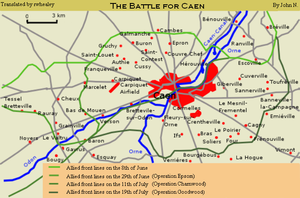Our website is made possible by displaying online advertisements to our visitors.
Please consider supporting us by disabling your ad blocker.
Battle for Caen
―
| Battle for Caen | |||||||
|---|---|---|---|---|---|---|---|
| Part of Operation Overlord | |||||||
 Battle for Caen | |||||||
| |||||||
| Belligerents | |||||||
|
|
| ||||||
| Commanders and leaders | |||||||
| Units involved | |||||||
|
2nd Army 1st Canadian Army | Panzer Group West | ||||||
| Strength | |||||||
|
4 armoured divisions 10 infantry divisions 1 airborne division 5 armoured brigades 3 tank brigades 2 commando brigades |
7 infantry divisions 8 panzer divisions ( 675 tanks) 3 heavy tank battalions 1 heavy panzerjäger battalion 2 sturmgeschütz companies 3 nebelwerfer brigades | ||||||
| Casualties and losses | |||||||
| 50,000 Allied casualties | 148,000 German casualties | ||||||
The Battle for Caen (June to August 1944) was a military engagement between the British Second Army and the German Panzergruppe West in the Second World War for control of the city of Caen and its vicinity during the Battle of Normandy.
Caen is about 9 mi (14 km) inland from the Calvados coast astride the Orne River and Caen Canal, at the junction of several roads and railways. The communication links made it an important operational objective for both sides. Caen and the area to its south are flatter and more open than the bocage country in western Normandy. Allied air force commanders wanted the area captured quickly to base more aircraft in France.
The British 3rd Infantry Division was to seize Caen on D-Day or to dig in short of the city. Caen, Bayeux and Carentan were not captured on D-Day and the Allies concentrated on linking the beachheads. British and Canadian forces captured Caen north of the Orne during Operation Charnwood (8–9 July). The suburbs south of the river were captured by the II Canadian Corps during Operation Atlantic (18–20 July). The fighting was mutually costly and greatly deprived the Germans of the means to reinforce the west end of the invasion front.
In the west the First US Army captured Cherbourg and took Saint-Lô, about 37 mi (60 km) west of Caen. on 19 July. On 25 July the First Army began Operation Cobra, co-ordinated with the Canadian Operation Spring at Verrières (Bourguébus) ridge, south of Caen. Much of Caen had been destroyed, particularly from Allied bombing; many French civilians were killed. After the battle, little of the pre-war city remained and reconstruction lasted until 1962.
Previous Page Next Page


